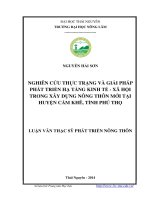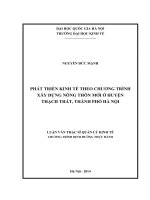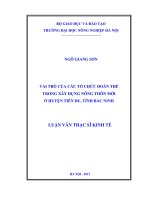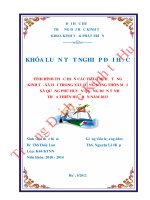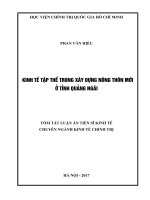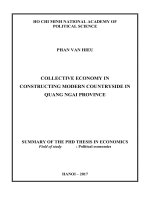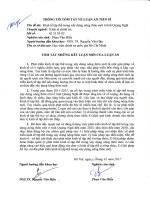Kinh tế tập thể trong xây dựng nông thôn mới ở tỉnh Quảng Ngãi (3)
Bạn đang xem bản rút gọn của tài liệu. Xem và tải ngay bản đầy đủ của tài liệu tại đây (216.82 KB, 32 trang )
HO CHI MINH NATIONAL ACADEMY OF
POLITICAL SCIENCE
PHAN VAN HIEU
COLLECTIVE ECONOMY IN
CONSTRUCTING MODERN COUNTRYSIDE IN
QUANG NGAI PROVINCE
SUMMARY OF THE PHD THESIS IN ECONOMICS
Field of study
: Political economics
HANOI – 2017
The thesis is completed at
Ho Chi Minh National Academy of Political Science
Science supervisor:
Assoc. Prof, Dr. NGUYEN VAN HAU
Counter-argument 1:
Counter-argument 2:
Counter-argument 3:
The thesis will be defended before the Thesis Committee
of Academy level, at Ho Chi Minh National Acedemy
At……hour……day……month ……year 2017
The thesis can be found at: The National Liberary and
the Liberary of Ho Chi Minh National Academy of Political Science
LIST OF THE AUTHOR’S PUBLISHED WORKS
RELATED TO THE THESIS
1. Phan Van Hieu (2011), Sustainable development of cooperatives in
Quang Ngai province, Journal of Central Vietnam Science-Society (3),
pg 25-36.
2. Phan Van Hieu (2013), Developing new-generation cooperative in
agricultre-countryside, new modern countryside construction solution
for Quang Ngai province, Journal of Central Vietnam Science-Society
(3), pg 19-27.
3. Phan Van Hieu (2016), Results and some experience from Tinh Tra
agricultre-countryside Agriculture Service Cooperative model, Son
Tinh district, Quang Ngai, Journal of Rationale Education (242), pg
154-156.
4. Phan Van Hieu (2016), Measures for sustainable new-generation
cooperative development in Vietnam, Journal of Finance, Issue 2 – May
2016 (633), pg 103.
5. Phan Van Hieu (2016), New-generation cooperatives: innovative rural
development solutions in Vietnam today, Journal of Finance, Issue 1 –
January 2016 (634), pg 55.
1
INTRODUCTION
1. The necessity of the thesis
Collective economy is a form of business organisation prevalent in
most countries in the world in the last 200 years. In Vietnam, this business
form has undergone 70 years of development, become an economic
component which is identified by the State and the Party along with other
economic components having an important role in the development of
socialist-oriented market economy. Developing collective economy is a
content and a criterion in constructing modern countryside in our country
from 2011 to date.
In recent years, Quang Ngai province has made decisions to implement
the guidelines and policies of the Party and State in order to develop
collective economy in the construction of modern countryside, achieving
many important achievements. However, the level of development is not as
desired, cooperatives are still small in scale, capital contributed by the
cooperative members is declining, bonding is underdeveloped, low efficiency,
sustainability of developing collective economy needs much more attention.
To help address this issue, on the basis of theoretical studies and
practical work at the author’s own business, the author selected the topic:
"Collective economy in the modern countryside construction in Quang Ngai"
to study as a doctoral thesis in the field of Economics-Politics.
2. The research purpose and tasks of this topic
2.1. The research purpose
Analysing and assessing the status of collective economy in the
construction of modern countryside in Quang Ngai during 2011-2015, to
propose viewpoints, orientations and measures to promote the development of
this business form in the coming period.
2
2.2. The research tasks
- Codifying, supplementing and developing a rationale basis about
collective economy in the construction of modern countryside in Vietnam in
the current period.
- Learning successful experience in developing collective economy
associated with constructing modern countryside in the world and in the
country as study materials for Quang Ngai to refer.
- Analysing and assessing the statusof collective economy in the
construction of modern countryside in Quang Ngai in 2011-2015.
- Recommending viewpoints, orientations and solutions to develop
collective economy in the construction of modern countryside in Quang Ngai
till 2020, with vision to 2030.
3. The subject and scope of research
3.1. Research subject
Collective economy nature as an economic relation, a form of
production and trading operation in rural areas associated with the program of
constructing modern countryside.
3.2. Research scope
- Scope of content: Thesis researches collective economy in
construction of modern countryside include forms of cooperation groups,
cooperatives, unions of cooperatives operating in industries and economic
sectors in rural areas, mainly studying the aspects of economic relations and
forms of business organisation.
- Scope of area: rural areas of Quang Ngai, with reference to
experience from overseas and some provinces and cities in Vietnam.
- Scope of time: Analysing and assessing the status of join ventures in
the construction of modern countryside in Quang Ngai during 2011-2015;
proposing orientation and solutions till 2020 with vision to 2030.
3
4. Rationale and research methodology of the thesis
4.1. Rationale
The author bases on the rationale and methodology of dialectical
materialism and historical materialism in the Marxism - Leninism to consider
and determine the rationale of collective economy in the construction of modern
countryside in Vietnam. Research of policies and evaluation of reality are also
based on Ho Chi Minh’s belief and perspective and renovation pathway of
Vietnam Communist Party and the policies and laws of the State, especially
since the promulgation and execution of Modern countryside constructing
Program.
4.2. Research methodology
The author uses generic methods, common in theoretical studies
including: method of scientific abstraction, method of systematisation, method
of logic combined with history, analysis and synthesis.
Using several methods of: gathering documents on mainstream
information channels about the object of study, method of reviewing reality,
method of using graphics and models to draw comments on the status of
collective economy in the construction of modern countryside in Quang Ngai,
clarifing the level of achievements, limitations and their causes.
The thesis author also uses, to a limited extent, forecast analysis method
and reference to some research results of scientific works.
5. Updated points in this thesis
- Systematising, supplementing and developing the rationale basis for
collective economy in constucting modern countryside in Vietnam from the
economic and political angles.
- Clarifying the status of collective economy in constructing modern
countryside in Quang Ngai in the 2011-2015 period, evaluating the results,
limitations and their causes.
4
- Recommending viewpoints, orientation and measures to promote the
development of collective economy in modern countryside construction in
Quang Ngai till 2020 with vision to 2030.
6. The thesis structure
Besides the introduction, conclusion, lists of reference and appendices,
the thesis is structured into four chapters, 11 sections.
Chapter 1
OVERVIEW OF THE STATUS OF RESEARCH RELATED TO JOINT
BUSINESS IN CONSTRUCTING MODERN COUNTRYSIDE
1.1. THE STATUS OF OVERSEAS RESEARCH RELATED TO JOINT
BUSINESS IN COUNTRYSIDE DEVELOPMENT
1.1.1. The rationale studies on collective economy in rural
development
In the research part the author focuses on these contents:
- Overview of research on the emergence and development of collective
economy.
- The role of collective economy in rural development.
- Principles and organisation of collective economy in rural areas.
1.1.2.
Researching
experience,
management,
organisation,
legislation and settlement of relations concerning collective economy in
rural areas
In this part, the author focuses on these contents:
- Researching experience in developing collective economy in rural
areas.
- Researching governance, organisation, legislation and political
aspects related to collective economy in the development of rural areas.
5
1.2. THE STATUS OF DOMESTIC RESEARCH RELATED TO JOINT
BUSINESS IN MODERN COUNTRYSIDE DEVELOPMENT
1.2.1. Theoretical studies on collective economy
In this part, the author reviews the research direction of the scientific
works, projects, articles of different authors published in Vietnamese in the
country related to the rationale and reality of collective economy
development, contents, viewpoints, orientation and solutions for collective
economy development.
1.2.2. Research studies on experience in collective economy
development
The author reviews the direction of research of studies mainly related to
collective economy development in the construction of modern countryside
on a national and provincial level which have been published in the form of
scientific research, books, doctoral theses and articles published in specialist
journals.
1.2.3. Research studies related to reality of organising and
developing collective economy in modern countryside construction
An overview of research in the last 10 years by a number of authors
through scientific works on the State level, ministerial level, the doctoral
theses, the articles published in specialist journals related to development
strategies for cooperatives, unions of cooperatives, about renewing the
organisation and management of cooperatives in agriculture and rural areas;
the barriers to the development of collective economy ... in which there have
been works concerning the rationale and practice of the construction of
modern countryside and development of collective economy in context of
constructing modern countryside.
1.3. CONCLUSIONS DRAWN FROM STUDIES RELATED TO THE
THESIS TOPICS AND ISSUES THAT NEED FURTHER INVESTIGATION
6
- The studies and articles published have solved many theoritical and
practical problems in collective economy related to construction of modern
countryside. Having interpreted the basic contents of the base of the
emergence and development of collective economy, confirming that the
alliance and cooperation in production and trading increases individual power
by multiple times. The development of cooperative forms is needed to create
the economic community, social development. Some studies have approached
from the history and development of cooperatives, through statistical
evidence. Having shown several meanings of the movements, scope of
collaboration, objectives and characteristics of a cooperative enterprise. Some
studies concerns about clarifying the contents, principles and organisation
form of collective economy in constructing modern countryside; there are
concerns about restructuring collective economy, association of collective
economy in rural areas. However, there are still many rationale and practical
contents that should be studied about collective economy in the construction
of modern countryside across the country and in the provinces remained
unanswered. So far, there has not yet a research work that studies in depth the
rationale and reatlity of construction of collective economy in constructing
modern countryside in Quang Ngai province from the political-economic
point of view.
- The raised issue and research direction of the thesis will be aimed at
the new points in the rationale cognition of collective economy in
constructing modern countryside in Vietnam in general and in a province in
particular; the advantages and disadvantages of Quang Ngai province, the
reality of collective economy in the constructing modern countryside in
Quang Ngai province, period of 2011-2015 and measures to promote its
development in association with constructing modern countryside in the
locality till 2020, with a vision to 2030.
7
Chapter 2
THE RATIONALE AND PRACTICAL BASIS OF JOINT BUSINESS
IN CONSTRUCTING MODERN COUNTRYSIDE
2.1. NATURE, FORMS, PRINCIPLES AND TRENDS OF COLLECTIVE
ECONOMY, THE RELATIONSHIP BETWEEN THE DEVELOPMENT OF
COLLECTIVE ECONOMY WITH CONSTRUCTING MODERN COUNTRYSIDE
2.1.1. Nature and forms of collective economy in constructing modern
countryside
- The emergence and development of collective economy
History shows that collective economy with its core as cooperatives
were first formed in Europe in the late eighteenth century. To date, collective
economy presents in180 countries and territories with many forms of
cooperatives in various fields such as agricultural cooperatives, service
cooperatives,
commerce
cooperatives,
credit
cooperatives,
housing
cooperatives, health care cooperatives, schooling cooperatives, energy
cooperatives, aged care cooperatives, attracting more than 800 million
members, creating jobs for about 3 billion people. Collective economy
emergence is objective, because the productive forces and the market
economy have reached a certain level of development. In Vietnam, collective
economy have existed for over 70 years in many industries and localities.
Collective economy development always goes hand in hand with rural area
development. In the current period, the development of collective economy is
placed in the contents and objectives of constructing modern countryside.
- Forms of collective economy in rural areas
Based on the nature and the degree of coherence between members,
industries of operation, the purpose of operation and legal knowledge level of
the operating mechanism, collective economy in rural areas can be divided
8
into four forms from low to high: group cooperatives lowest, followed by
cooperative communes, cooperative unions and cooperative enterprises is
highest.
- The nature of collective economy in constructing modern countryside
From the approached, the nature of collective economy in the
constructing modern countryside not only reflects the nature of cooperatives
in general but also its nature in the constructing modern. The nature of
collective economy is an social-economic relation in which workers,
households and legal entities established linkages, mutual assistance in
manufacturing, business, creating jobs, creating wealth to meet development
needs of the community. Collective economy bases on the members'
ownership and collective ownership, which are formed and operate on the
principle of voluntary contributions of fund and efforts to address more
effectively the problems in production, business and life. Collective economy
is a mean to create the social-economic basis for construction of modern
countryside across the country as well as in each locality.
2.1.2. Principles and trends of collective economy development
2.1.2.1. Principles of emergence and development of collective
economy
Because cooperatives are a key part of collective economy, defining
principles of organisation and operation of this economic relation must be
approached from principles of organisation and operation of cooperatives.
Since the appearance of the first cooperative in the world, there have been
many sets principles underpinning the organisation and operation of a
cooperative. The most common content which is set by ICA nowadays
includes nine principles: helping each other; self-responsibility; selfmanagement; each member having equal voting right; dual nature; dual
market; dual ownership and dual accounting; dual monitor; and social
9
responsibility. In Vietnam, the Law on Cooperatives in 2012 identifies seven
principles for organising and operating cooperatives.
2.1.2.2. Trend of collective economy development in rural areas
Entering the twenty-first century, due to the impact of various
economic, political and social factors, collective economy around the world
develop in a trend of increasing development of cooperatives in rural areas in
agricultural and service sectors: aged care, education, health care, housing,
funeral service, social welfare services; Cooperatives exist, operate and
develop side by sides with businesses in rural areas. In Vietnam,collective
economy in rural areas develop in the trend of new type of cooperatives
where cooperatives serve members, agricultural services, people's credit funds
in which cooperative members are fund providers and at the same time
borrowers from the fund, environmental sanitation cooperatives, clean water
cooperatives,
electricity
cooperatives,
local
market
management
cooperatives...
2.1.3. Constructing modern countryside, the relationship between
constructing modern countryside and the development of collective
economy in Vietnam
2.1.3.1. Constructing modern countryside
Construction of modern countryside is a Vietnam policy to constantly
improve the material and spirit life of rural residents, harmonising across
regions, creating a faster change faster in disadvantaged areas; farmers are
trained to get production skills equal to those of developed countries in the
region and to possess political boldness to be in control of modern
countryside. The government has issued National Criteria of modern
countryside with 19 contents as a basis, striving so that in 2015, 20% of
communes meeting modern countryside standards, with the 13th criterion:
10
there must be forms of cooperative group or cooperative communes operating
effectively in modern countryside.
2.1.3.2. The relationship between the development of collective
economy and constructing modern countryside in Vietnam
Development of collective economy aims focus not only on economic
development, but also social development and environmental protection, the
process of creating economic forms as a basis to promote constructing
modern countryside. Collective economy given development will generate
material resources and other necessary conditions for the constructing modern
countryside. In its turn, the achievements of the constructing modern
countryside create demand and better conditions for development of
collective economy forms. Tying collective economy development to the
constructing modern countryside is an effective solution for sustainable
development in rural areas.
2.2.
CONTENTS
OF DEVELOPING
COLLECTIVE
ECONOMY IN
CONSTRUCTING MODERN COUNTRYSIDE, ACCESSMENT CRITERIA AND
CONDITIONS TO ENSURE IMPLEMENTATION
2.2.1. Contents of developing collective economy in constructing modern
countryside
- Developing collective economy diverse in forms and joint ownership
in rural areas
- Developing collective economy in multiple scales and levels, linking
with external economic entities.
- Harmoniously tying economic objectives to social objectives and the
ecological environment in the development of collective economy in
constructing modern countryside.
2.2.2. Criteria for accessing development of collective economy in
constructing modern countryside
11
Based on the experience of other countries, when considering the level
of success of the cooperative movement and the Criteria set for modern
countryside issued by the Prime Minister in 2009, the author identifies the
criteria for evaluating the level of development of collective economy in the
construction of modern countryside in our country, including the target
growth rate of production value, the contribution of collective economy in
total rural output, the increase of the total number of collective economy in
rural areas over time, changing the structure in collective economy in line
with development trends and the requirements of building modern
countryside, the change in the total number of cooperative members and the
total number of full-time employees working regularly, changes in profits ...
in collective economy over time.
2.2.3. Necessary conditions for development of collective economy in
constructing modern countryside
- People’s and the authorities’ level of awareness of the role of
collective economy in the construction of modern countryside should be
enhanced.
- The values and fundamental principles of collective economy must be
followed.
- Institutional and social psychology environment for collective
economy development must be favourable.
- There must be the necessary support from the State and organisations
for collective economy.
- The extent and consequences of the construction of modern
countryside.
2.3. DOMESTIC AND INTERNATIONAL EXPERIENCE IN DEVELOPING
COLLECTIVE ECONOMY IN CONSTRUCTING MODERN COUNTRYSIDE
2.3.1. India’s experience
12
Cooperation movement was triggered in India in 1904. To date, it is
estimated to be 230 million members, more than two thirds of which live in
rural areas. Cooperatives are developed in various sectors, mainly service
sector. They not only provide strategic input for agriculture workers, but also
to meet their consumption needs at preferential prices, and support farmers to
overcome the volatility of agricultural prices. Cooperative development is
considered to be strategic to strong economic growth. This provides lessons
about expanding the scope of cooperatives in a diversified, multi-purpose
trend; Cooperative unions switching to limited liability business forms.
2.3.2. Experience of developing collective economy in constructing
modern countryside in some provinces of Vietnam
- Experience in developing livestock cooperatives of Hanoi.
Foreseeing the huge demand of food supply in the locality, to deal with
the situation of rampant "dirty" food in the market, Hanoi City People's
Committee has supported farmers to develop areas for keeping pigs in the
suburban districts in collective economy form. Cooperatives collaborate with
the specialised agencies at all levels and businesses in technical training,
application of new technologies, environmental treatment, epidemic
prevention, consumption of livestock products. Thus, the scale fresh food
production has grown, with development of cooperatives, possitively
contributing to constructing modern countryside and for members.
- Soc Trang province’s experience.
To develop collective economy associated with constructing modern
countryside, Soc Trang province attaches great importance to the propaganda
of Operative Act 2012, technical training and improvement human resources
quality for the cooperative. Agriculture cooperative model Evergrowth
acquired from Canada of developing of dairy production industry combined
13
with processing and bundled services has proved to be effective and is being
replicated.
2.3.3. Lessons drawn for Quang Ngai province
Firstly, collective economy development pathway and trend are
inevitable.
Secondly, compliance with the principles of organisation and operation
of collective economy is compulsory.
Thirdly, the State plays a vital role in shaping, creating environment
and supporting collective economy to develop.
Fourthly, always giving importance to ensuring the combination of
collective common interests and those of participants.
Chapter 3
REALITY OF COLLECTIVE ECONOMY IN CONSTRUCTING
MODERN COUNTRYSIDE IN QUANG NGAI PERIOD OF 2011-2015
3.1. ADVANTAGES AND DISADVANTAGES OF NATURAL, ECONOMIC
AND SOCIAL CONDITIONS IN QUANG NGAI RELATED TO COLLECTIVE
ECONOMY IN CONSTRUCTING MODERN COUNTRYSIDE
3.1.1. Advantages of natural, economic and social conditions in
Quang Ngai related to collective economy in constructing modern
countryside
- Advantages of natural conditions: Is a half-mountain half-plain area
with coastal plains. There are many conditions to develop collective economy
in industries, forestry and fisheries, most notably offshore fishing.
- Advantages of economic and social conditions: Hardworking people,
with a tradition of solidarity, unity, have been active in the production and
trading of market mechanisms and faced competitive pressures.
3.1.2. Disadvantages of natural, economic and social conditions in
Quang Ngai related to collective economy in constructing modern
14
countryside
In particular, the biggest difficulty is that the starting point of Quang
Ngai rural areas is small and scattered production with many outdated
elements, the population’s knowledge is limited, especially the minorities, the
majority of farmers still hesitate to join cooperatives due to the effect of the
cooperative model.
3.2. THE STATUS OF IMPLEMENTATION, APPLICATION OF POLICIES
AND GUILDLINES BY THE PARTY AND THE STATE ON COLLECTIVE
ECONOMY DEVELOPMENT IN CONSTRUCTING MODERN COUNTRYSIDE
IN QUANG NGAI
3.2.1. Policies and guildlines by the Party and the State on
collective economy development in constructing modern countryside
Modern countryside constucting program was initiated in 2008 in our
country. Earlier, the Party and State have issued guidelines and policies to
promote the development collective economy, especially Resolution 13-NQ /
TW (2002) by the 9th Executive Committee of central Party; followed by
Resolution No. 26-NQ / TW (2008) by the 10th Executive Committee of
central Party on agriculture, farmers, rural areas, in which the development of
collective economy is an important solution in constructing modern
countryside.
On 28/10/2008, the Government issued Resolution No. 24/2008 / NQCP of the Action Program, identifying modern countryside in our country;
followed by Decision 800 QD-TTg (2010) of the National Target Program on
constructing modern countryside from 2010 to 2020, identifing 19 national
criteria as standards for the constructing modern countryside. Developing
collective economy is a part in constructing modern countryside and one of
the requirements of national criteria for modern countryside. Striving so that
in 2015, the country will have 65% of communes meeting standards and in
2020 75% of communes are of modern countryside standards.
15
3.2.2. Reality of implementation and application of guidelines and
policies of the Party and State to develop collective economy in
constructing modern countryside in Quang Ngai
- On viewpoints, mechanism and policies:
To implement the guidelines and policies of the Party and State,
Provincial Party Committee and People's Committee of Quang Ngai has led
and direct organising implementation of collective economy development
plans in the construction of modern countryside. Some major guidline and
policy decisions: Agenda for Action 29 / CTr-TU dated 19/11/2008 of the
Provincial Party Committee; Resolution No. 18/2009 / NQ- HĐND on
development of agriculture, farmers and rural areas in 2010-2020. The 18th
Provincial Party Congress Quang Ngai (2010) issued resolution on economicsocial development period of 2010-2015, in which: "To develop
comprehensive agriculture towards industrialisation and modernisation
associated with good settlement farmer problems and constructing modern
countryside, considering thí a key task in the coming time." Resolution No.
03-NQ/TU on developing agriculture, constructing modern countryside in
Quang Ngai in 2011-2015 phase and orientation to 2020. In particular, "strive
so that in 2015, more than 50%, 2020 70% of cooperative achieve good and
excellent ranks".
- On implementation organisation:
Quang Ngai People's Committee and relevant authorities have issued
specific plans and schemes, notably the Scheme to consolidate, develop and
enhance the operational efficiency of cooperatives in the province of Quang
Ngai till 2015, with direction to 2020; Agricultural Development and Modern
Countryside Construction Scheme Quang Ngai in 2011-2015; NTM plans to
build in Quang Ngai province in 2011-2015 and direction to 2020. Allocating
to local government branches and departments with specific regulations and
guidelines for achieving collective economy development goals with its core
16
as cooperatives of reasonable and sustainable growth, contributing to
economic growth and social stability; focusing on strengthening existing
cooperatives, in 2015 lowering the ratio of poor-performace cooperatives to
below 10% and 2020 basically no poor-performance cooperatives remain.
Provincial Cooperative Union is responsible for coordinating with the
involved departments, agencies and localities to extensively promote the
contents of the Scheme in large scale and depth.
3.3. EVALUATION OF COLLECTIVE ECONOMY DEVELOPMENT
STATUS IN CONSTRUCTION OF MODERN COUNTRYSIDE IN QUANG NGAI
PERIOD OF 2011-2015
3.3.1. Results achieved
- The number of collective economy in rural areas rose, diversified in
forms and fields of operation
In the period 2011-2015, the number of collective economy in rural
areas has changed significantly: In 2011, the province has 1,248 collective
economy units then in 2015 there were 6704 units, up 5.4 times since 2011.
Group cooperative has the fastest growth, from 1,037 units in 2011 to 6,500
units in 2015, an increase of nearly 6.3 times in 5 years. In 2015, out of 245
cooperatives in Quang Ngai, 204 operated in rural areas, accounting for
83.3% of the total number of cooperatives in the province.
Collective economy in rural areas were established and operated
diverse industries and economic sectors, both in agriculture, industry and
services. In particular, the number of collective economy in the field of seabased industries were thriving. In 2015, the cooperative economic structure
was 92% of agriculture and 6% of Services.
Most cooperatives active in agriculture has conducted multi-sector
business, mainly agricultural services such as irrigation, tillage, supplying,
fertilising, veterinary, plant varieties, livestock, agricultural tool supply,
product sales, processing, internal credit, commerce and agricultural training.
17
Considering the presence each cooperative sector in rural areas of
Quang Ngai in 2015, the figures are: 92% of cooperatives worked in irrigation
service; 70% in agricultural training service; 70% in veterinary service; 41%
in plant protection service; 40% in animal breed and plant variety service;
27% in internal credit service; 14% in fertilising service; 11% in tillage
service and 4% in product sales.
Among group cooperatives, 56.4% operated in services such as savings
and loans, solidarity fishermen group, salamander breeding, chicken keeping,
pig keeping, broom production, mushroom cultivation, forest plantations,
cattle club and cooking. In particular, in 2015 the province had had 8
cooperatives in fishing bundled services and offshore fishing, 300 group
cooperatives united to exploit the seas and 1 group cooperative develop into
cooperative of service and offshore Ly Son Hoang Sa fishing. Collective
economy development not only meet constructing modern countryside
requirements but also associated with national maritime sovereignty
protection given complicated movements of the current situation.
- Collective economy attracted many members, creating jobs for
workers in rural areas.
By the end of 2015 collective economy in rural areas have attracted
436,283 members, an increase of 63.3% compared to 2011 (46.3% of group
cooperatives and 53.7% of cooperatives). Group cooperative membership
growth in 2011-2015 is 427.9%. Number of full-time workers in cooperatives
and group cooperatives in 2015 was more than 1.8 times higher than in 2011.
- Collective economy being developed created conditions for
concentration and ability to increase capital efficiency.
Compared with 2011, capital concentrated in collective economy of
rural in Quang Ngai increased 1.8 times, from nearly 420.7 billion dong in
2011 to nearly 753 billion dong in 2015. The growth of capital concentration
18
is a condition for collective economy to apply technical innovation,
technology, expand production scale, making it possible to increase efficiency
of investment capital.
During this period, revenues and profitability of collective economy in
rural areas rose: 2015 compared to 2011, total revenues increased by 1.77
times and total profit by 1.63 times; the operation of People's Credit Fund was
more effective than that of cooperatives.
- Initially formed economic relations in rural areas
Some cooperatives signed binding contracts with enterprises to
guarantee consumption of farming products for family businesses as
agricultural service cooperatives, rural Tinh Tra, mushroom production and
trading cooperative Duc Nhuan, Binh Duong agricultural service
cooperative, cane-growing cooperative Pho Nhon, etc.
- Collective economy being developed contributed significantly to the
implementation of the constructing modern countryside criteria
First, collective economy contributed to the economic and organisation
of production in rural areas criteria: collective economy became "godfather"
for the development of family business, many cooperatives have contributed
to the creation of jobs, increased income, and poverty reduction for rural
residents. Contributing to cultural, environmental, safe, organic, ecological
agricultural production criteria, etc.
Second, collective economy made important contribution to criteria of
construction of economic infrastructure in rural areas. Of the 204 cooperatives
and 6,500 group cooperatives in rural areas, many engaged in construction
and electricity services in rural areas energy projects (REII), service of
science and technology in agriculture and rural areas. For example, Dai An
Dong agriculture cooperative (Nghia Hanh district) is the main force to focus
on fund raising from the people for development of production and
19
investment in constructing infrastructure under modern countryside
construction criteria; agriculture service cooperative Binh Duong (Binh Son
district) is the construction head unit in building anti-salt dykes to turn the
wasteland into "golden fields"...
Third, collective economy also created favorable conditions to fulfill
criteria of planning and implementing social-economic development plans in
the rural society. Collective economy proved to have many advantages over
individual business in the formulation and implementation of social-economic
development, in bringing scientific and technological advances, promoting
economic restructuring in rural areas. Appeared some representative
cooperatives in constructing modern countryside, such as agriculture
cooperative Binh Duong, Dong Ky Nghia, fishing logistics services Binh
Chanh cooperative, Binh Thanh electric service cooperative, etc.
3.3.2. Limitations and their causes
3.3.2.1. Limitations
- Although the forms and ownership of collective economy were
diverse, they but did not develop as expected. In the 2011-2015 period, a
number of criteria for collective economy development in constructing
modern countryside were not achieved. Meaning, the forms and ownership of
collective economy in rural areas of Quang Ngai were only developed in the
increasing number of group cooperatives, while that of cooperatives virtually
stalled, even decreased.
- The size of collective economy is small, capital contributed by
cooperative members decreases, the bonding is underdeveloped. The
performance of the 13th criterion in constructing modern countryside of many
cooperatives and group cooperatve still faced difficulties. There was still a
lack of participation of potential investors such as legal entities, entrepreneurs
and state officials in forms of collective economy. Joint ownership,
20
connection and cooperation between cooperatives and organisations and
individuals at home and abroad to achieve the cooperative operation
objectives are in an initial phase.
- The number of members in the collective economy has increased, but
not meaningful. Many members are indifferent to the collective economy they
participate. Surveys and actual investigations by the author show that more
than 70% of members who were polled did not care about the survival of
agriculture cooperatives in the province. Many members are indifferent to the
operation of the collective economy they participate in.
- Business performance of many collective economy is low. In the
period 2011-2015, while total capital base of collective economy increased by
nearly 1.7 times, revenues increased only 1.8 times, ie. no significant increase
in productivity. Margin on sales of was about 2.3-2.6% pa, lower than savings
interest during the same period (saving deposit rate was 14.0% in 2011, 6.5%
in 2015).
Despite the fact that collective economy activities are not only for
profit purposes, but also for social objectives, because it is necessary to assist
each other in the community of rural areas, but the low efficiency of
collective economy will negatively impact the development process of this
economic form itself.
3.2.2.2. Causes of the limitations
- Internal causes:
+ The development level of productive forces in Quang Ngai rural
areas is low, infrastructure–technology facilities are poor, small-scale
production is still widespread, commodity economy is undeveloped.
+ The knowledge level of rural residents is still limited, not yet escaped
from the psychological inferiority for old-style models, not yet realised
superior advantages of this economic form compared with individual
21
businesses and small ownership.
+ The capacity of collective economy administration is weak, not
enough to create "momentum" for collective economy units and compel
people to really participate.
- External causes:
+ The economic environment of the country in general, in Quang Ngai
province in particular has some disadvantages. After the global financial crisis
of 2008-2009 to the present, the world economy has not yet recovered.
+ The legislative environment is not truly apparent for collective
economy to grow. Although Cooperative Law, enacted in 2012, created a legal
framework for the construction and development of a new generation of
cooperatives, it lacks of policy consistency, some contents are not explained
specifically.
+ The implementation of state policies on collective economy
development associated with constructing modern countryside in some Party
Committees and government branches from provincial to commune level
lacks consensus, inconsistencies with uncoordination.
Chapter 4
ORIENTATION AND SOLUTIONS TO PROMOTE DEVELOPMENT
OF COLLECTIVE ECONOMY IN CONSTRUCTING MODERN
COUNTRYSIDE IN QUANG NGAI
4.1. OBJECTIVES, VIEWPOINTS AND DIRECTION FOR COLLECTIVE
ECONOMY DEVELOPMENT IN CONSTRUCTING MODERN COUNTRYSIDE
IN QUANG NGAI TILL 2020, WITH VISION TO 2030
4.1.1. Context, objectives and tasks of constructing modern
countryside in Quang Ngai
- Context of constructing modern countryside
22
As of 25/08/2016, there were 2,134 communes meeting 19 modern
countryside criteria, including 2,025 officially recognised as modern
countryside communes, accounting for 22.7% of the total number of
communes. In Quang Ngai, the National target Program on constructing
modern countryside had 11 communes meeting 19 criteria and 16 communes
meeting15-18 criteria, 50 communes meeting 10-14 criteria, 52 communes
meeting 5-9 criteria and 35 communes meeting 0-4 criteria.
However, the result is not commensurate with the potential, not
sustainable in development, constructing modern countryside is still heavy on
infrastructure investment, debts on construction are high; high-tech
application in farming and breeding is of small-scale, yet to create a linking
system between production, processing and sale of agricultural products; the
role of "godfather" of agriculture cooperatives for farmers is very weak...
- Objectives of constructing modern countryside in Quang Ngai:
Striving so that for the period 2016 - 2020 the province will have 55
districts and 2 communes meeting modern countryside criteria; no communes
under 5 criteria; each mountainous district will have at least one commune
meeting modern countryside criteria. Ie the number of modern countryside
communes will 5.5 times of that in 2015.
- The content components of the program to construct modern
countryside in Quang Ngai include: construction planning of modern
countryside, improving economic efficiency in rural areas, poverty reduction
and social security.
4.1.2.
Perspective
of
collective
economy
development
in
constructing modern countryside in Quang Ngai province till 2020, with
vision to 2030
First, developing collective economy in constructing modern
countryside should be placed in conditions of development of socialist-
